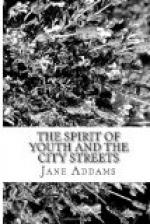The theater also has a strange power to forecast life for the youth. Each boy comes from our ancestral past not “in entire forgetfulness,” and quite as he unconsciously uses ancient war-cries in his street play, so he longs to reproduce and to see set before him the valors and vengeances of a society embodying a much more primitive state of morality than that in which he finds himself. Mr. Patten has pointed out that the elemental action which the stage presents, the old emotions of love and jealousy, of revenge and daring take the thoughts of the spectator back into deep and well worn channels in which his mind runs with a sense of rest afforded by nothing else. The cheap drama brings cause and effect, will power and action, once more into relation and gives a man the thrilling conviction that he may yet be master of his fate. The youth of course, quite unconscious of this psychology, views the deeds of the hero simply as a forecast of his own future and it is this fascinating view of his own career which draws the boy to “shows” of all sorts. They can scarcely be too improbable for him, portraying, as they do, his belief in his own prowess. A series of slides which has lately been very popular in the five-cent theaters of Chicago, portrayed five masked men breaking into a humble dwelling, killing the father of the family and carrying away the family treasure. The golden-haired son of the house, aged seven, vows eternal vengeance on the spot, and follows one villain after another to his doom. The execution of each is shown in lurid detail, and the last slide of the series depicts the hero, aged ten, kneeling upon his father’s grave counting on the fingers of one hand the number of men that he has killed, and thanking God that he has been permitted to be an instrument of vengeance.
In another series of slides, a poor woman is wearily bending over some sewing, a baby is crying in the cradle, and two little boys of nine and ten are asking for food. In despair the mother sends them out into the street to beg, but instead they steal a revolver from a pawn shop and with it kill a Chinese laundry-man, robbing him of $200. They rush home with the treasure which is found by the mother in the baby’s cradle, whereupon she and her sons fall upon their knees and send up a prayer of thankfulness for this timely and heaven-sent assistance.
Is it not astounding that a city allows thousands of its youth to fill their impressionable minds with these absurdities which certainly will become the foundation for their working moral codes and the data from which they will judge the proprieties of life?




